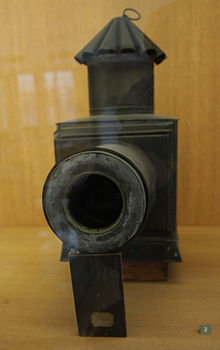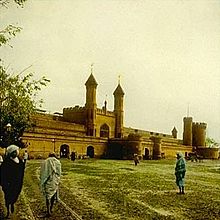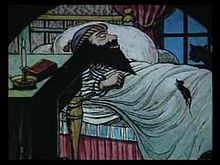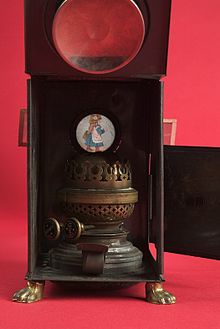- Magic lantern
-
This article is about the slide projector prototype. For other uses, see Magic lantern (disambiguation).
The magic lantern or Laterna Magica is an early type of image projector developed in the 17th century.
Contents
Operation
The magic lantern has a concave mirror in front of a light source that gathers light and projects it through a slide with an image scanned onto it. The light rays cross an aperture (which is an opening at the front of the apparatus), and hit a lens. The lens throws an enlarged picture of the original image from the slide onto a screen.[1] Main light sources used during the time it was invented in the late 16th century were candles or oil lamps. These light sources were quite inefficient and produced weak projections. The invention of the Argand lamp in the 1790s helped to make the projected images brighter. The invention of the limelight in the 1820s made it even brighter, and following that the inventions of the electric arc lamp in the 1860s, and then incandescent electric lamps all further improved the projected image of the magic lantern.[2] It was also an important invention for the motion picture film and 45mm projector because of its ability to screen moving images. To achieve this, mechanical slides were used to make the images move. This was done using two glass slides, one with the part of the picture that would remain stationary and one with the part of the picture that would move on a disc. The glass slides were placed one on top of the other in an orderly fashion and a hand-operated pulley wheel was used to turn the movable disc.[3] The magic lantern also led directly to Eadweard Muybridge's invention of the zoopraxiscope, which was another forerunner for moving pictures.
History
There has been some debate about who the original inventor of the magic lantern is, but the most widely accepted theory is that Christiaan Huygens developed the original device in the late 1650s.[4] In the fifteenth century, however, Giovanni Fontana, a Venetian engineer, had already created a lantern that projected an image of a demon. And other sources give credit to the German priest Athanasius Kircher. He describes a device such as the magic lantern in his book Ars Magna Lucis et Umbrae.[5][6] There are possible mentions of this device associated with Kircher as early as 1646. Even in its earliest use, it was demonstrated with monstrous images such as the Devil.[1] Huygens's device was even referred to as the "lantern of fright" because it was able to project spooky images that looked like apparitions.[3] In its early development, it was mostly used by magicians and conjurers to project images, making them appear or disappear, transform from one scene into a different scene, animate normally inanimate objects, or even create the belief of bringing the dead back to life.[7]
In the 1660s, a man named Thomas Walgensten used his so-called "lantern of fear" to summon ghosts. These misuses of this early machine were not uncommon. In fact, a common setup of the machine was to keep parts of the projector in a separate, adjoining room with only the aperture visible, to make it seem more magical and scare people. By the 18th century, use by charlatans was common for religious reasons. For example, Count Cagliostro used it to "raise dead spirits" in Egyptian masonry. Johann Georg Schröpfer used the magic lantern to conjure up images of dead people on smoke. He staged routines doing this at his coffee shop in Leipzig. He did this to scare people and make them think he was a good actor. Schröpfer ended up going crazy and thinking he himself was pursued by real devils, and shot himself after promising an audience he would later resurrect himself.[8]
Phantasmagoria
The later part of the 18th century was the age of Romanticism and the Gothic novel. There was an obsession with the bizarre and the supernatural.[3] Johann Georg Schröpfer began using the magic lantern in séances, before Paul Philidor refined the techniques. In these shows, the illusionists used the magic lantern to trick people into thinking that they had summoned up spirits of revolutionary figures with the lantern mounted on a trolley. They also summoned ghosts by requests. However, Philidor's show was eventually closed by the authorities due to their paranoia.[7] The audiences of these magic lantern shows reacted to the projections with bewilderment. They thought the projections were real dreams, visions, apparitions and ghosts, and the devil. This was just fueled by the fact that this is exactly what the early conjurers and magicians used them for: scaring people using these ghostly images.[9] The next famous conjurer to utilize the magic lantern was Etienne-Gaspard Robert.
He was a Belgian inventor with an interest in magic. He held his first "fantasmagorie" at Pavillon de l'Echiquier in Paris. He began experimenting in the 1780s with techniques used to make phantasmagorias, which is basically the use of the magic lantern to conjure up supernatural images such as the devil, phantoms, or ghosts. If the images were projected onto a gauze screen, they would even seem to be floating in air, making the stunt even more believable-looking. At Pavillon de l'Echiquier, Robertson set up a public phantasmagoria and told the audience he would conjure up their dead relatives. He made a big show out of it and conjured up an image of a phantom with a dagger, and then pictures of the dead relatives. After this show, he continued to make other, bigger, more outrageous spectacles.[10] He put the magic lantern onto wheels and patented this under the name of 'fantascope'.[3] He eventually moved his work to a theater, where he built up a show to a big finale in which big shapes moved around the otherwise dark theater.[10] Robertson also used mechanical slides to make his images move. There is a small collection of transparencies at Conservatoire National des Arts et Métiers in Paris which shows a two-piece slide he used with one glass showing the face of a phantom and the other which had the image of the eyes, which when used meant the eyes could roll back and forth. Also, Robertson used multiple lanterns to project both a moving figure as well as a background for that figure. For example, a stationary projector in the front would have projected an image of a church courtyard while a moving projector from behind would project the image of the phantom The Bleeding Nun, an image which came from the novel The Monk by Matthew Gregory Lewis.[3] His shows were extremely successful.[10] The popularity increased and eventually this phenomenon moved to England. Many observers have been quoted saying these "ghosts" were very realistic, which is partly due to people's eyes not being trained to the phenomenon of photography and cinematography like ours today are.[10]
More recent uses
Eventually, the magic lantern came to America. It continued to be used by magicians but also to project moving images for entertainment. There were even some examples of pornographic striptease slides starting in the 1920s and proceeding into the first half of the 20th century. Today, the magic lantern is primarily only used by collectors.[7] Collector Pierre Albanese and Thomas Bloch, a musician specialist of rare instruments (the glass harmonica which was originally used in Phantasmagoria during the 18th and 19th centuries, cristal Baschet, ondes Martenot, nail violin also originally used...) have premiered a live Magic Lantern show in 2008 which tours since this date.
See also
- Projector (disambiguation) for a directory of projector types
- Zoopraxiscope
- Film
- Phantasmagoria
References
- ^ a b Pfragner, Julius. "An Optician Looks for Work". The Motion Picture: From Magic Lantern to Sound. Great Britain: Bailey Brothers and Swinfen Ltd. 9-21. Print.
- ^ Waddington, Damer. "Introduction". Panoramas, Magic Lanterns and Cinemas. Channel Islands, NJ: Tocan Books. xiii-xv. Print.
- ^ a b c d e Barber, Theodore X. "Phantasmagorical Wonders: The Magic Lantern Ghost Show in Nineteenth-Century America." Film History 3,2 (1989): 73-86. Print.
- ^ Pfragner, Julius. "Index". The Motion Picture: From Magic Lantern to Sound. Great Britain: Bailey Brothers and Swinfen Ltd. 226. Print.
- ^ Waddington, Damer. "Introduction". Panoramas, Magic Lanterns and Cinemas. Channel Islands, NJ: Tocan Books. xiii-xv. Print.
- ^ Ars Magna Lucis et Umbrae. Athanasius Kircher. 1671. http://books.google.com/books?id=Gki6ZIbrgQ8C. Retrieved 19 August 2010.
- ^ a b c Eds. Crangle, Richard, Heard, Mervyn, and van Dooren, Ine. "Devices and Desires". Realms of Light. London, England: The Magic Lantern Society, 2005. 11-45. Print.
- ^ Eds. Crangle, Richard, Heard, Mervyn, and van Dooren, Ine. "Devices and Desires". Realms of Light. London, England: The Magic Lantern Society, 2005. 11-45. Print.
- ^ Vermeir, Koen. "The Magic of the Magic Lantern (1660-1700): On Analogical Demonstration and the Visualization of the Invisible." British Journal for the History of Science 38,2 (2005): 127-159. Print.
- ^ a b c d Castle, Terry. "Phantasmagoria and the Metaphorics of Modern Reverie." The Female Thermometer. New York, NY: Oxford University Press, 1995. 140-167. Print.
External links
- magic-lantern.eu website with more than 5200 lantern slides online
- Cinema and its Ancestors: The Magic of Motion Video interview with Tom Gunning
- A live Magic Lantern performance with accompaniment of crystal instruments is proposed here – feat. Pierre Albanese and Thomas Bloch
- Live Magic Lantern Shows The American Magic Lantern Theater
- Magic Lantern – A School of Cinema Film Institute Chennai
- University of Tasmania Library Lantern Slide Collection
Categories:- Display technology
- History of film
- Precursors of photography
- Italian inventions
Wikimedia Foundation. 2010.





